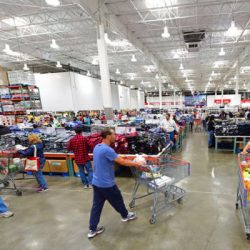Costco: a case of vertical integration

Many companies tweak textbook business models for running their businesses. Understanding those business models can be complicated, but not impossible.
All retail store chains face a common problem: supply chain disruption. Supply chain management is very important for companies. Each year, millions of dollars are spent worldwide to train professionals to master the art of supply chain management. Auditors are hired to conduct supply chain audits to find out weaknesses and suggest improvements in existing supply chains.
Two (main) attributes of any supply chain:
Time
Time in this context means delivery of products to store shelves. There is a misconception that delays (alone) cause supply chain disruption. Many times the early arrival of some products creates unforeseen warehouse space shortage affecting other products or business processes.
Cost
The companies cannot always pass on the increase in cost price to their customers. The retail store management might consider switching suppliers or discontinuing any product.
There are infinite possibilities that may cause supply chain disruptions. Many companies adopt “vertically integrated business model” for better management of the supply chain.
In a vertically integrated business model, the primary business takes over control (partial or full) of the supply chain.
There are two (main) methods of vertical integration:
- Controlling the supply chain through active participation (e.g. investment in suppliers’ business in any form)
- Setting up (from scratch) a separate production and/or manufacturing facility
America and the retail market
With a population of 328 Million, America’s total retail sales in the year 2018 clocked up over US $5.16 Trillion. People know of the popular American retail giants like Walmart and Amazon, but there are many other retail chains which control a significant share of America’s retail sales. One such retailer is Costco.
Costco at a glance
Costco “wholesale” is a multinational retail giant. It markets itself as a “membership-only warehouse club” and rightly so. You have to become a member to buy from Costco. Costco earned annual membership fees of US $3.14 Billion (for the year ended 2018) which is 2.27% of its Net Sales. The layout of its stores matches those of warehouses.
Costco is lean on overheads. Pallets are stacked up with products containing items in bulk packaging. Costco is not your roadside store. It is a shopping warehouse for large families and small businesses.
Key Information:
Annual Revenue (for the year ended 2018):
US $138.4 Billion
Number of members (card holders – all categories):
94.3 Million
Total number of warehouses:
768 (November 2018)
533 locations in 44 U.S. States & Puerto Rico, 100 locations in nine Canadian provinces, 28 locations in the United Kingdom, 13 locations in Taiwan, 15 locations in Korea, 26 locations in Japan, 10 locations in Australia, 39 locations in Mexico, 2 locations in Spain,1 location in Iceland and 1 location in France.
Number of Employees (US):
163,000 (full and part-time)
Number of Employees (Worldwide):
239,000 (full and part-time)
Chicken and Costco
Costco’s ready to eat Rotisserie chicken is a favourite meal of American households. It sells 60 million (approx) meals each year at the rate of US $5 per meal. Carrying on with our approximate sales figure the annual revenue from Rotisserie chicken sales is US $300 Million.
The American poultry market is dominated by 3 companies; Tyson, Pilgrim’s Pride and Perdue. All three of them are facing lawsuits for unethical business practices. There have been recalls of poultry products because of contamination. Cartelisation of poultry business has further suffocated business growth in the poultry sector. All of these factors have hiked poultry prices. Costco, operating on low margins cannot afford to offer Rotisserie chicken at US $5 in this business environment. Therefore, the store adopted a vertically integrated business model by setting up its own poultry processing center.
Costco and Nebraska Plant
CNBC (22 Jan 2019) reports,
“In fall 2019, Costco will open a chicken farming operation in eastern (Fremont) Nebraska. This venture will provide Costco with 100 million chickens, 40 percent of its yearly chicken needs, allowing it to partially escape the American chicken oligopoly run by the likes of Tyson, Pilgrim’s Pride and Perdue”.
The initial estimates of the project cost are US $275 Million. Work is being carried out to launch the facility in September 2019.
Costco: Will the new business model succeed?
A shift to vertically integrated business model is not always successful. However, the following factors increase Costco’s probability of success:
- Costco’s financials are strong.
- The estimated annual revenue from sales of Rotisserie chicken is US $300 Million (approx 60 million chickens) whereas estimated project cost is US $275 Million (for processing 100 million chickens). The project budgets are confidential information and are not shared by companies, but these figures alone show that the project will be a game changer for the company.
- It is not Costco’s first such business venture. Since the mid-1980s, Costco has maintained the prices of its hot-dog-and-soda deal at US $1.50 (mainly) because the company produces the hot dogs at its Costco Tracy Meat Plant in Tracy, California.
Nebraska poultry plant will reduce the risk of chicken supply chain disruption and will be economically beneficial for Costco, but local business conditions and farmer unions might jack up the project outlay or subsequent operational costs.


